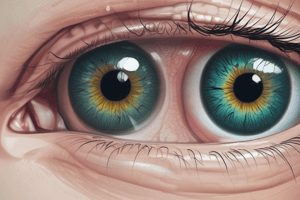Podcast
Questions and Answers
What is the primary characteristic of physiological anisocoria?
What is the primary characteristic of physiological anisocoria?
- Always indicates a serious underlying condition
- Associated with chronic infections
- Unequal pupil sizes without an underlying pathological cause (correct)
- Caused by oculosympathetic interruption
Which demographic is most commonly affected by Tonic (Adie’s) pupil?
Which demographic is most commonly affected by Tonic (Adie’s) pupil?
- Women aged 20-40 years (correct)
- Children under 10 years
- Elderly individuals over 75 years
- Men aged 40-60 years
What underlying condition can cause Horner’s syndrome?
What underlying condition can cause Horner’s syndrome?
- Viral infection
- Hernia
- Asthma
- Carotid artery dissection (correct)
What is the birth prevalence of congenital Horner’s syndrome?
What is the birth prevalence of congenital Horner’s syndrome?
Argyll Robertson pupil is associated with which condition?
Argyll Robertson pupil is associated with which condition?
What symptom is considered a hallmark of Holmes-Adie syndrome?
What symptom is considered a hallmark of Holmes-Adie syndrome?
What is the primary clinical effect of a lesion causing Argyll Robertson pupil?
What is the primary clinical effect of a lesion causing Argyll Robertson pupil?
Which of the following conditions is NOT a possible association of Tonic (Adie’s) pupil?
Which of the following conditions is NOT a possible association of Tonic (Adie’s) pupil?
Flashcards
Physiological Anisocoria
Physiological Anisocoria
Unequal pupil sizes without a known medical cause. May occur in up to 20% of people, more common with age.
Tonic (Adie's) Pupil
Tonic (Adie's) Pupil
A rare condition where the pupil is dilated and reacts slowly to light but constricts well to near objects. Often linked to absent or weak tendon reflexes.
Horner's Syndrome
Horner's Syndrome
Caused by damage to the sympathetic nerve pathway, leading to a smaller pupil, drooping eyelid, and sometimes decreased sweating on the same side of the face.
Argyll Robertson Pupil
Argyll Robertson Pupil
Signup and view all the flashcards
Pupil Anomalies
Pupil Anomalies
Signup and view all the flashcards
Neurosyphilis
Neurosyphilis
Signup and view all the flashcards
Tonic Pupil
Tonic Pupil
Signup and view all the flashcards
Horner's Syndrome in Children
Horner's Syndrome in Children
Signup and view all the flashcards
Study Notes
Pupil Anomalies: Aetiology
- Benign vs. Serious: Many pupil anomalies are benign, but some indicate serious, even life-threatening, underlying conditions.
- Scope: This guideline focuses on physiological and pathological pupil abnormalities, excluding traumatic, surgical, or pharmacological causes.
Physiological Anisocoria
- Definition: Unequal pupil sizes without a pathological cause.
- Characteristics: Idiopathic, stable, long-standing, and varies with illumination (up to 20% of individuals). Prevalence increases with age.
- Prevalence: Up to 20% of individuals, increasing with age.
Tonic (Adie's) Pupil
- Cause: Parasympathetic denervation at the ciliary ganglion.
- Demographics: Most common in women aged 20-40, a prevalence of 2 per 1,000.
- Potential Associations: Often idiopathic, but can be linked with viral infections (e.g., varicella-zoster), connective tissue diseases (e.g., Sjögren's, rheumatoid arthritis), and general peripheral or autonomic neuropathies.
- Holmes-Adie Syndrome: Associated with absent or poor tendon reflexes.
Horner's Syndrome
- Cause: Interruption of oculosympathetic innervation from the hypothalamus to the orbit (congenital or acquired).
- Age Range: Occurs at any age; birth prevalence ≈ 1 in 6250 (congenital).
- Potential Associations (Serious): Often benign or post-surgical; can indicate carotid dissection, stroke, multiple sclerosis, or neoplasia (e.g., Pancoast tumor).
- Painful Horner's: A common ocular sign of internal carotid artery dissection.
- Pain Presentation: Ipsilateral orbital, facial, or neck pain is reported in up to 58% of cases with internal carotid artery dissection.
- Common Cause in Children: Birth trauma is the most frequent cause in children.
Argyll Robertson Pupil
- Cause: Lesion in the midbrain affecting the pupillary light reflex pathway but sparing the near reaction pathway.
- Association: Commonly associated with neurosyphilis.
- Presentation: Observed during tertiary or late stages of syphilis infection.
Predisposing Factors
- Tonic Pupil: Female gender.
- Horner's Syndrome: Birth trauma (in children).
- Argyll Robertson Pupil: Syphilis
Symptoms of Pupil Abnormalities
- Generally Asymptomatic: Many abnormalities cause no symptoms.
- Possible Symptoms: Pain, photophobia, or visual disturbance may accompany some pupil abnormalities.
Signs of Pupil Abnormalities
- Physiological Anisocoria: Unequal pupil sizes (≥0.5mm) are usually a finding that is simple.
Studying That Suits You
Use AI to generate personalized quizzes and flashcards to suit your learning preferences.




